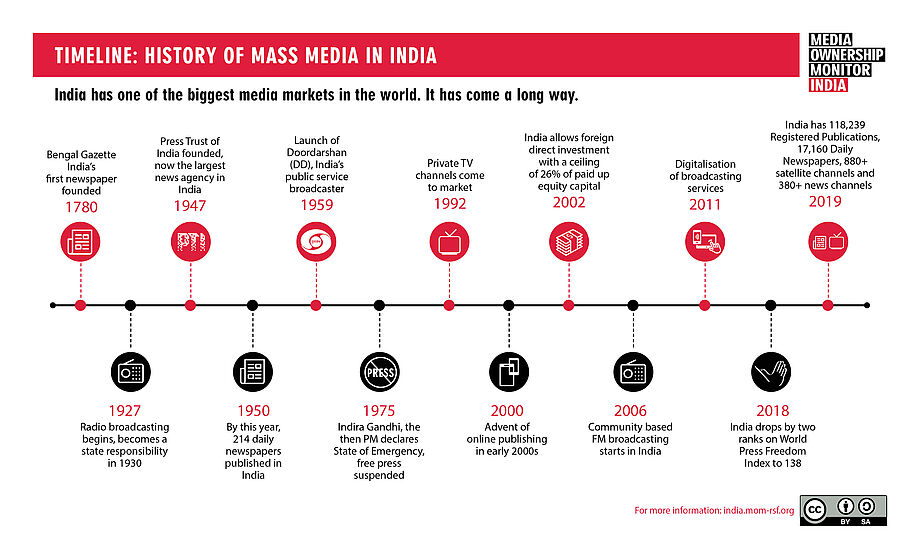History
The Indian media has a long history spanning from the colonial past in the second half of the 18th century to the present as the largest functioning democracy of the 21st century.
When the British were firmly entrenched in the country and the Indian freedom movement was still in its nascent stage the newspapers of the late 18th century entered the country not only through the rulers but also to, a great extent, for the British readers in India and abroad. Back then, publishing houses were created as private commercial enterprises, which has not changed much throughout the years. The Indian newspaper saga started with an Irishman - James Augustus Hicky. Hicky launched the “Bengal Gazette” in 1780, India’s first newspaper, in English. Before that, the British East India Companies’ rules did not encourage the establishment of newspapers in India. Just to make sure that his paper was perceived as “independent”, Hicky added a line to his masthead – “A weekly Political and Commercial Paper - Open to all parties, but influenced by none”. Hicky’s paper was a bit tabloid, and a bit satire paper. It lacked the tone of overly “serious news” evident in other British papers of that time. He initially used the paper to take on personal adversaries by usually mocking them. Copying the British newspaper style, it initially targeted only the British residents as readers. A campaign against the first Governor General of India however caused what can be pointed out as the first censorship in India when the “Bengal Gazette” was banned from circulation through official channels. It was that incident that reportedly sharpened Hickey’s perception of how free the press should be to be able to serve its purpose. He devoted lots of space to social issues and anti-war content, including the voice of the general public. After a period of fighting back, delivering his newspapers in neighbourhoods, even keeping the publishing going during him being arrested, the first newspaper of India was finally crashed by the previously targeted Governor General and the Supreme Court in 1782. Although the reach and its time of existence where limited one can say it inspired others to launch newspapers, too. Alongside the Bengal Gazette newspapers like the ‘Bombay Herald’ and ‘Bombay Courier’ in 1789 and 1790 respectively, and ‘Bombay Gazette’ in 1791 entered the market. But soon the government clamped down on the freedom of press, obviously rattled by extensive criticism by the latter. For more than two decades after that, the gagging of the press continued as successive Governor Generals in India refused to cede freedom to the press.
The Media Fans Spirit of Independence
It was in 1822, that social reformer Raja Ram Mohan Roy began the awakening of the Indian public for independence through his publications. Roy is credited with the first vernacular newspapers in Bengali and Persian called Sambad Kaumidi and Mirat-ul-Akhbar, respectively. As a reformist he used his publications to spread awareness about social evils like “Sati” (a barbaric practice where the wife of a deceased man immolates herself on her husband’s pyre). Lord William Bentinck, a relatively liberal Governor General at the time, supported Indian efforts at reforms, which resulted in 33 English language and 16 Indian language publications in India by the year 1830. The first Hindi language newspaper was the “Udant Martand” (The Rising Sun), first published in the year 1826 as a weekly by Pandit Jugal Kishore Shukla, a lawyer by profession. As the voice of the native language press was in particular expressive and strong with its views against the British government, a law called the Vernacular Press Act was brought in 1878 to curb the non-English, Indian language press. The Act, issued by the then Viceroy, Lord Lytton, clearly intended to stop the vernacular press from criticising the government’s policies. Since the reach of the vernacular press was constantly rising, the Act was intended as a method to stop spreading unrest against the British rule. It was later repealed by Lord Rippon in 1881. Throughout time several newspapers played important roles for India on its way towards independence such as the Indian owned platform the “Tribune”. After covering the “Amritsar Massacre” in 1919, it was shut down and its editor, Kali Nath Ray had been sent to jail.
The Governments Role in Radio Broadcasting
Radio in India has an interesting origin. In 1923 and 1924 3 Radio Clubs in Bombay, Calcutta and Madras (today Chennai) started their services airing mostly music and talks for a couple of hours a day. Due to financial issues, they had to shut down already in 1927. Under an agreement between the Indian Government and a private company, operating under the name Indian Broadcasting Company Ltd. (IBC) a broadcasting service was set up the same year in Bombay and Calcutta followed by a shutdown of the IBC and the government taking over their assets. Subsequently, the Department of Labour and Industries, under a new name – the Indian State Broadcasting Corporation, started operations on a trial basis. Since then Radio broadcasting in India has been under the government control. In 1936, the company was renamed All India Radio – AIR – as the state-run radio service. In 1956, the state broadcaster, All India Radio was again renamed “Akashvani” (Voice From The Sky). A year later, AIR launched Vividh Bharati (roughly translated, Variety India) – with film music as its mainstay. Nowadays AIR, as well as private commercial radio stations (FM) and community radio stations make up the radio landscape of India. Although FM-Stations are allowed to air the unaltered news, produced by All India Radio, they are restricted by law to produce news themselves. As of the TRAI Consultation Paper on Issues related to Digital Radio Broadcasting in India, AIR covers, with 420 radio stations, almost 92% of the country and 99.20% of the whole population. That makes radio a particularly strong tool for the government to maintain control over news production and public opinion, especially due to the low literacy rates in rural areas where a major amount of the public might not afford a TV or be able to read a newspaper. This might also explain the heavy regulation that exists in the radio broadcast media which is put in place for ‘the safety of the country, national security and public order’.
Television
Subheader Television in India began at a very modest note. From a test transmission beginning on 15 September 1959, television grew wings as the years rolled on. Until 1975, only seven Indian cities had access to Doordarshan, the national television service run by the government. In 1982, under Prime Minister Indira Gandhi, colour television arrived in India. But it was not until 1991 that things changed dramatically for the Indian television viewer. With CNN beaming the 1991 Gulf War live into Indian homes, the country got a taste of international television - up, close and personal. Coincidentally, it was the same year when the Indian government opened up the economy and allowed private satellite television channels to beam into India. For the first time, Indian viewers got a chance to watch non-Doordarshan shows, were spoilt for choice and for the first time many television networks including Sun Network, Zee Network and STAR Network became household names. STAR in particular, aired some of the famous English serials from foreign countries and suddenly, India had unrestricted access to these global entertainment properties. A look at the current media scenario overall will give a sense of the magnitude of explosion the sector has seen in India. Today there are 1,18,239 media publications, 38,933 weekly newspapers and magazines, 17,160 daily newspapers, more than 880 satellite television channels, more than 380 news television channels, and 550+ non-news entertainment radio stations. According to the statistics portal Statista, the pay TV penetration in India by cable and satellite was 82% in the year 2018 and is likely to grow to 84% by the year 2023.
Challenges for the Indian Media
Encouraging throughout the scenario today, Indian media has had to go through some upheavals at different points in its history. In 1975, an embattled Prime Minister of the country, Mrs Indira Gandhi – faced with many charges of corruption and misuse of authority declared Internal Emergency in the country. Fundamental rights were suspended and press freedom was curtailed. Much later, when Mrs. Gandhi’s son, Rajiv Gandhi was the Prime Minister, he tried to bring in an Anti-Defamation Law against what was called as “criminal imputation” and “scurrilous writings”, effectively discouraging journalists from investigating the government. Gandhi later withdrew the Bill, faced with extraordinary protest from around the country. Even in the current government headed by Narendra Modi, there is an overwhelming feeling that the Press does not get to do its job, and dissent is not taken kindly by the political class.
Despite challenges, Indian media is one of the most enduring features of its democracy. Though faced with challenges repeatedly, the media has tried to play the role of a watchdog, and has, quite often, justified the title of being the fourth pillar of Indian democracy.
Sources
Media in India: Raj to Swaraj
Retrieved from Shodhganga on 22 May 2019
The first British newspaper in India was a satirical tabloid
Retrieved from THEWEEK on 22 May 2019
Excerpt: Hicky’s Bengal Gazette; The Untold Story of India’s First Newspaper by Andrew Otis
Retrieved from hindustantimes on 22 May 2019
History Of Freedom Of The Press In India Before Independence
Retrieved from Shodhganga on 22 May 2019
In fact: The crisis of the Chandra Shekhar months, borrowings and recovery
Retrieved from The Indian Express on 22 May 2019
Do you know the History of Newspaper in India?
Retrieved from Josh Jagran on 22 May 2019
On This Day in History: May 30, 1826 – The first Hindi language newspaper ‘Udant Martand’ was published
Retrieved from THE FREE PRESS JOURNAL on 22 May 2019
Radio in India:The FM Revolution and Its Impact on Indian Listeners
Retrieved from bepress on 22 May 2019
This Day in History (8-Jun-1936) – All India Radio was established
Retrieved from This Day in History on 22 May 2019
Paid cable and satellite TV penetration rate in India from FY 2018 to FY 2023
Retrieved from statista on 22 May 2019
James Augustus Hicky- “Pioneer Of Press In India”
Retrieved from SIKKIM EXPRESS on 22 May 2019
For wider reach, AIR news to be shared with FM radios
Retrieved from hidustantimes on 22 May 2019
iConsultation Paper No. 7 /2017Consultation Paper On Issues related to Digital Radio Broadcasting in India
Retrieved from TRAI on 22 May 2019
Consultation PaperonIssues related to Community Radio Stations
Retrieved from TRAI on 22 May 2019
Why can't pvt radio broadcast news? Surpreme court to center
Retrieved from Times of India on 22 May 2019
Radio and Television as Mass Media
Retrieved from DIRECTORAT OF DISTANCE EDUCATION GURU JAMBHESHWAR UNIVERSITY OF SCIENCE & TECHNOLOGY HISAR - HARAYANA (INDIA)



